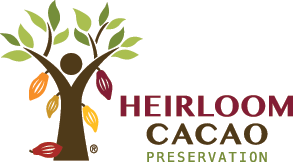/ Chocolate Resources / Chocolate Making Lessons / Lesson—Tasting Chocolate
Lesson—Tasting Chocolate

Understanding how to taste chocolate to determine quality. Up until the twenty-first century, most North Americans thought that chocolate only had one flavor because chocolate bars and confections were primarily made of a homogenous milk chocolate. But in fact, chocolate manufacturers produce a great variety of chocolates—from fine couvertures used by luxury chocolatiers to compound coatings used for mass production.
In our Chocolate Masters Video we discuss Choosing Fine Chocolate:
Exploring the Ingredients that Contribute to Flavor in Chocolate:
Cocoa Liquor
Cocoa Liquor (also called chocolate liquor) has nothing to do with alcohol - the liquor term refers to the fact that cocoa beans when ground become a liquid as the cocoa butter is heated and released from the cells in the grinding process. Similar to what happens when you grind nuts. Cocoa Liquor is simply roasted and ground cocoa beans, which contain cocoa bean solids and cocoa butter. The flavor of the chocolate is determined by its origin, fermentation by the farmer, roasting and conching of cocoa beans by the chocolate manufacturer. Home cooks are familiar with this product: it is sold as "unsweetened" chocolate in the grocery store.
Cocoa Butter
The flavors of the cocoa butter, while more subtle than the cocoa liquor, can vary depending on its origin. Rather than having an impact on the flavor, what the cocoa butter brings to chocolate is “mouth-feel.” That is, how the cocoa butter distributes the flavor around your mouth. Cocoa butter also produces a slight “cooling” sensation in your mouth that you might have noticed. The cocoa bean contains approximately 50 – 53 percent cocoa butter.
Sugar and Sweeteners
Sugar is to chocolate what salt is to other foods. A little enhances the flavor of the cocoa liquor, but too much makes it unpalatable. High-grade cane or beet sugar is used in the manufacturing of fine chocolate. Chocolate sweetened by other types of sweeteners are now readily available on the market if you have dietary or ethical restrictions.
Milk or Cream
There are different milk products used in the manufacture of milk chocolate. These include condensed milk, dry milk powder, dry cream powder, or milk crumb (which is a process that brings a rich caramelized flavor to the milk chocolate).
Spices
Spices can include such ingredients as Vanilla or Vanillin (an artificial vanilla), cinnamon, cassia oil and other essential oils.
Lecithin
Lecithin is added during conching as an emulsifier and stabilizer in order to improve the fluidity and texture of the chocolate. Texture also plays a role in flavor, so I have included it as a flavor ingredient. Many fine chocolate makers and manufacturers are switching from GMO soy lecithin to lecithin from other natural sources.
Fat Substitution for Cocoa Butter
There are a number of tropical fats, such as coconut oil and palm kernel oil, that are used in place of cocoa butter in the manufacture of compound chocolate coatings to reduce costs, improve production time (no tempering) and increase storage limits. These products cannot use the name "real chocolate" and are sold as "Compound Coating," "Decorator's Chocolate," "Confectioner's Coating," "Summer Coating" or "Paté Glacée." If you are not sure if you are buying real chocolate or confectioner's coating, look at the ingredients—real chocolate does not contain any fats or oils except cocoa butter.
How to Taste Chocolate
The following instructions will help you to compare the taste between different chocolates. I suggest you compare chocolate bars that are the same flavor, such as semisweet or milk chocolate.
First, use your eyes. The visual qualities that distinguish a fine, well-tempered chocolate include:
- Shine/gleam finish for molded confections or solid chocolate bars and novelties
- Satin/gleam finish for chocolate dipped confections
Chocolate can range in color from a deep dark brown to a reddish brown. Color depends on the origin of the cocoa beans, how they were roasted and whether they were Dutch processed. Depth of color is not an indication of quality or richness of flavor.
Then, use your fingers. If possible, break off a piece of the chocolate—you should hear a distinct snap. This is the sound of stable crystallization breaking cleanly, which means the chocolate was processed and correctly tempered (i.e., prepared by a specific heating and cooling process) - a sign of careful craftsmanship.
Hold the piece of the chocolate between your fingers and notice how quickly it melts. Rub your fingers together with the chocolate to test its smoothness. Cocoa butter melts more quickly than sugar so the higher the proportion of cocoa butter, the more quickly it will melt.
Then, use your nose. Lift your fingers with the melted chocolate to your nose and cup your other hand around your fingers in front of your nose. This will help to capture the aromas. It should smell like deep, rich chocolate with floral, fruity or sugary (caramel) aromas—not metallic or medicinal.
Finally, taste the chocolate. Place a small piece of chocolate on your tongue and let it slowly melt. Once the chocolate has melted, run your tongue around your mouth to get the full “mouthfeel” of the texture—it should be full and velvety. As a result of the conching process, fine chocolate will be very smooth compared to cheap chocolate, which may be gritty.
Notice the “finish.” There shouldn’t be a waxy or greasy film left in your mouth after you swallow. Cocoa butter dissipates, leaving only the flavor behind. If that flavor lingers for a while in your mouth, the chocolate is said to have a long finish.
Want to know much more about chocolate tasting? Check out our MASTERING CHOCOLATE FLAVOR PROGRAM

If you enjoyed this lesson, you might also like:
Understanding Cocoa Percentage
Get reminders about upcoming classes! To receive program updates and news, click the link below.
Photography by Jessica Washburn, Bliss Chocolatier and Ecole Chocolat






